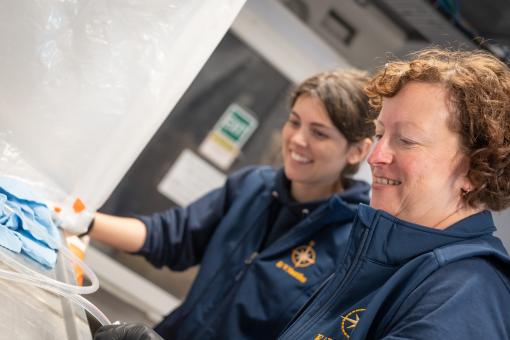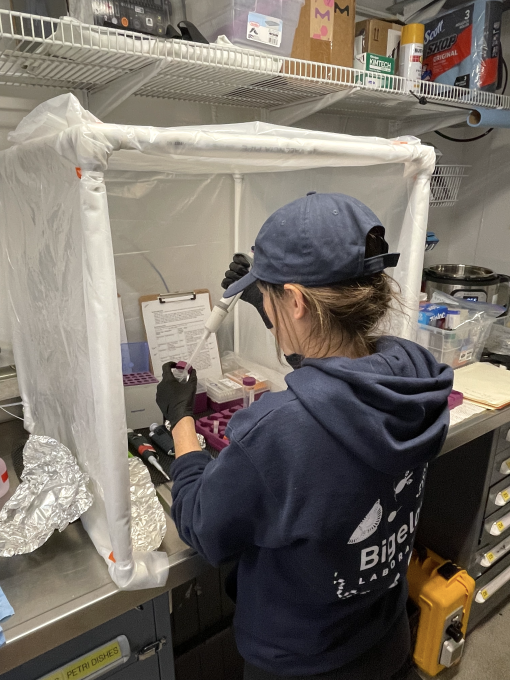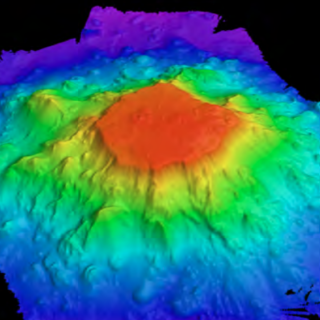Science Spotlight — Investigating the Microbial Services of Invisible Actors in Seabed Rocks

Joining us on expedition Luʻuaeaahikiikekumu is Dr. Beth Orcutt, a Senior Research Scientist at Bigelow Laboratory for Ocean Sciences. As we investigate the ancient seamounts of the Liliʻuokalani Ridge Seamounts, Orcutt is guiding the team in looking deeper at life on and within the rocky basalt slopes which characterize deep seamount slopes.
While the ROV camera views quickly spot coral colonies and the colorful and charismatic life on the seabed, there is an important and poorly understood realm of life playing out in front of the cameras but in miniature.The term microbes encompasses bacteria, protists, and any life that requires a microscope to view. Microbes play key roles in the ocean in processing chemicals into available energy for other animals, aging and transforming minerals in rocks, and supporting ecosystems.

Orcuttʻs team is studying the microbial communities residing within the ferromanganese crusts found over rock surfaces of these explored seamounts. Ferromanganese crusts (multi-mineral compounds made up primarily of iron and manganese) are formed from dissolved chemicals in the seawater precipitating out of solution onto substrates like ancient lava flows from volcanoes. These crusts are formed throughout the worldʻs ocean, but ideal oceanographic conditions for deposition are found across the Central Pacific. While there is growing commercial interest in these crusts for the critical minerals they may contain, there is a tremendous amount left to be known about how the characteristics of the crusts vary from region to region in ocean basins as well the microorganisms that live on and within them. These studies will help provide baseline information on the living communities of these seamounts which can inform management and conservation measures.
During ROV dives, Dr. Orcutt and the team have a sampling plan to keep eyes out for rounded rocks which seem to have thick crusts acretted around the original rocks. Across the eleven ROV dives on nine seamounts and ridges, the team has collected samples from different depths and oxygen concentrations to examine the variety of communities found on the seabed. Each time a rock sample is collected, surrounding seawater is also captured in a Niskin sample so the microbial communities from the surrounding water and within the crusts can be compared.
Once back on Nautilus, research continues in the shipʻs wet lab. Since microbes are everywhere — including in the air around us — Orcutt and undergraduate research assistant, Annabelle Adams-Beyea, built a pop-up clean room for sample processing. This PVC structure contains all sample jars, pipettes, and is sterilized with UV light before each round of sample processing to limit cross contamination.

Quickly after returning to the ship, manganese crusts and included microbes are chipped off from the sampled rocks and crushed into small grain size. Samples for each different analysis are processed and packaged for futher study.
Different analyses will help answer questions about the how many microbes are within the crusts, what the genetic diversity of those microbes is, as well as what genes are active within their strucutures, or “scientifically reading their instruction books”, Adams-Beyea says.
This research is supported by a NOAA Ocean Exploration federal funding opportunity, supplementing the basic exploration goals of the biodiversity and geologic landscapes supported by the Ocean Exploration Cooperative Institute and Office of National Marine Sanctuaries. While all of Papahānaumokuākea Marine National Monument is protected from future mineral extraction, research here on local seafloor microbial communities will help form a baseline for comparison of conditions across the Pacific and for seamounts throughout the ocean. These studies will also contribute to the mission of a new National Science Foundation-funded internal research coordination network called the Crustal Ocean Biosphere Research Accelerator (COBRA).

Luʻuaeaahikiikekumu - Ancient Seamounts of Liliʻuokalani Ridge
This expedition will have E/V Nautilus returning to Papahānaumokuākea Marine National Monument (PMNM) to build on the accomplishments of the 2021 Luʻuaeaahikiikalipolipo expedition, which mapped the previously unmapped Liliʻuokalani Ridge Seamounts. The team returns for the first visual exploratory surveys of the seamount chain looking to investigate a puzzling split in the seamount trail.





